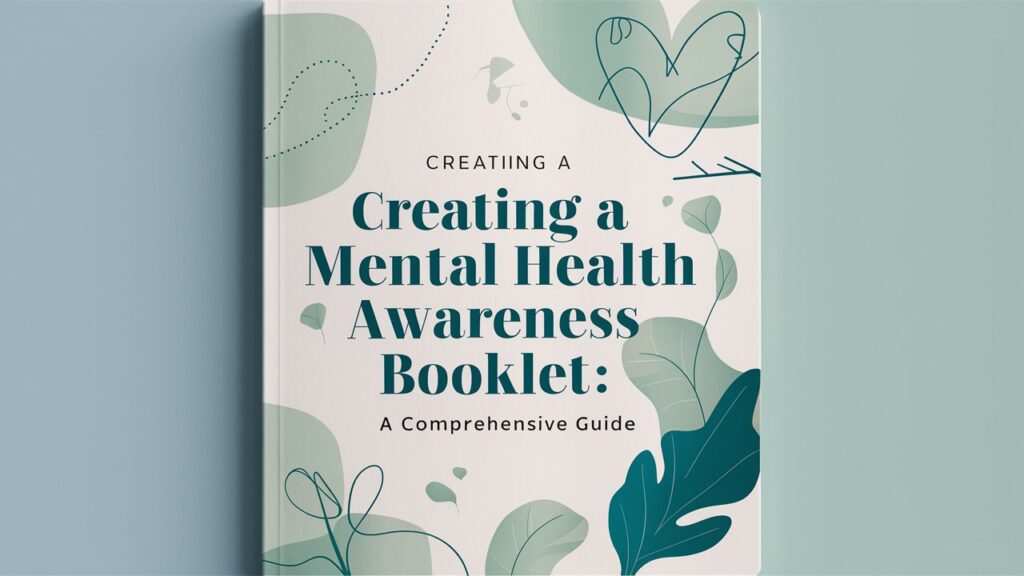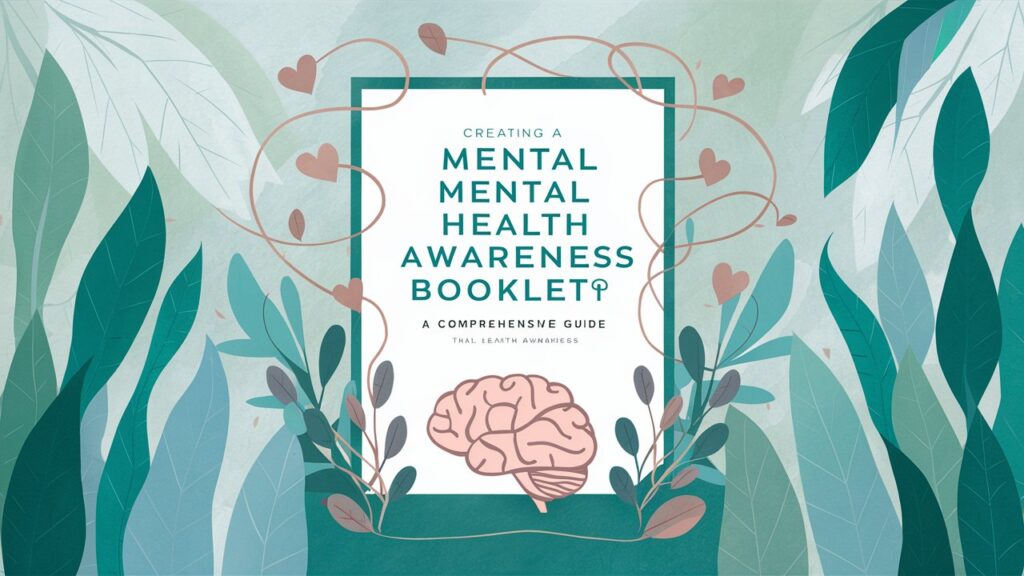Creating a Mental Health Awareness Booklet: A Comprehensive Guide

Mental health awareness is a crucial aspect of promoting well-being in society. Despite growing recognition of the importance of mental health, stigma, misinformation, and a lack of accessible resources continue to be significant barriers. One effective way to contribute to the mental health conversation is by creating a mental health awareness booklet.
This booklet can serve as a valuable resource to educate, inform, and empower individuals to understand mental health better and seek help when needed.
In this article, we will explore the importance of mental health awareness, the process of creating a mental health awareness booklet, the key topics to cover, and how to distribute and use the booklet effectively.
Understanding the Importance of Mental Health Awareness
1. Reducing Stigma
Mental health stigma remains a pervasive issue, discouraging many individuals from seeking the help they need. Misconceptions about mental health conditions can lead to discrimination, social isolation, and a reluctance to discuss mental health openly. By creating a mental health awareness booklet, you can contribute to reducing this stigma by providing accurate information and challenging harmful myths.
2. Increasing Knowledge and Understanding
A mental health awareness booklet can serve as an educational tool to increase knowledge and understanding of mental health. It can provide readers with information about common mental health conditions, signs and symptoms, treatment options, and ways to support others. By enhancing understanding, the booklet can help individuals recognize mental health issues early and take appropriate action.
3. Encouraging Help-Seeking Behaviour
Many people hesitate to seek help for mental health issues due to fear, shame, or a lack of awareness about available resources. A well-crafted booklet can include information about where to find help, how to access mental health services, and what to expect from treatment. This can encourage individuals to seek help sooner, potentially preventing mental health conditions from worsening.
4. Promoting Self-Care and Well-Being
Mental health is not just the absence of mental illness; it also involves positive mental well-being and self-care. A mental health awareness booklet can provide tips and strategies for maintaining good mental health, such as stress management techniques, healthy lifestyle choices, and mindfulness practices. Promoting self-care can empower individuals to take proactive steps to protect and enhance their mental health.
Steps to Create a Mental Health Awareness Booklet

1. Define Your Purpose and Audience
Before you start creating your mental health awareness booklet, it’s essential to define your purpose and target audience. Ask yourself the following questions:
- Purpose: What is the primary goal of the booklet? Are you aiming to raise general awareness, provide specific information about a particular mental health condition, or offer resources and support?
- Audience: Who is your target audience? Are you creating the booklet for a general audience, students, parents, professionals, or a specific community? Understanding your audience will help you tailor the content and tone of the booklet to meet their needs.
Once you have a clear purpose and audience in mind, you can start planning the content of the booklet.
2. Conduct Research and Gather Information
Accurate and reliable information is the foundation of an effective mental health awareness booklet. Conduct thorough research to ensure that the content you provide is up-to-date, evidence-based, and relevant to your audience. Some sources to consider include:
- Mental Health Organizations: Websites and publications from reputable mental health organizations, such as the National Alliance on Mental Illness (NAMI), Mental Health America (MHA), and the World Health Organization (WHO).
- Peer-Reviewed Journals: Research articles and studies published in peer-reviewed journals can provide valuable insights into mental health conditions, treatments, and interventions.
- Expert Interviews: Consider interviewing mental health professionals, such as psychologists, psychiatrists, or counselors, to gather expert opinions and advice for your booklet.
- Personal Stories: Including personal stories from individuals who have experienced mental health challenges can add a human element to the booklet and make it more relatable to readers.
3. Outline the Content
Creating an outline for your mental health awareness booklet will help you organize the information and ensure that you cover all the necessary topics. Here’s a suggested outline:
- Introduction
- Brief overview of the importance of mental health awareness.
- Purpose of the booklet.
- Acknowledgment of the audience.
- Understanding Mental Health
- Definition of mental health.
- The difference between mental health and mental illness.
- Common mental health conditions (e.g., depression, anxiety, bipolar disorder, schizophrenia).
- Signs and Symptoms
- How to recognize signs and symptoms of mental health conditions.
- The importance of early intervention.
- Seeking Help
- How to access mental health services.
- Types of mental health professionals (e.g., therapists, counselors, psychiatrists).
- What to expect from therapy and treatment.
- Self-Care and Coping Strategies
- Tips for maintaining mental well-being.
- Stress management techniques.
- Mindfulness and relaxation exercises.
- The role of physical health in mental well-being.
- Supporting Others
- How to support someone experiencing mental health challenges.
- Active listening and empathy.
- Resources for caregivers and loved ones.
- Resources
- List of mental health organizations, hotlines, and online resources.
- Recommended books, articles, and videos.
- Conclusion
- Recap of key points.
- Encouragement to seek help and support.
- Final message of hope and empowerment.
4. Write and Design the Booklet
Once you have your outline, it’s time to start writing the content for your mental health awareness booklet. Here are some tips for writing and designing an effective booklet:
- Use Clear and Simple Language: Avoid jargon or overly complex language. Write in a way that is easy for your audience to understand, regardless of their level of knowledge about mental health.
- Be Compassionate and Non-Judgmental: Mental health is a sensitive topic, so it’s important to approach it with empathy and compassion. Avoid language that could be perceived as judgmental or stigmatizing.
- Incorporate Visuals: Use images, illustrations, and infographics to break up the text and make the booklet more engaging. Visuals can also help to clarify complex information and make it more accessible.
- Highlight Key Points: Use headings, bullet points, and bold text to highlight important information. This makes it easier for readers to find the key points and takeaways.
- Include Personal Stories: Personal stories and testimonials can make the booklet more relatable and inspiring. Consider including quotes or short stories from individuals who have experienced mental health challenges and found help.
5. Review and Edit
Before finalizing your mental health awareness booklet, it’s important to review and edit the content thoroughly. Check for accuracy, clarity, and consistency in the information provided. You may also want to have the booklet reviewed by a mental health professional or an editor to ensure that the content is reliable and well-written.
6. Design the Layout
The design and layout of your mental health awareness booklet are crucial in making it visually appealing and easy to navigate. Consider the following design elements:
- Cover Page: The cover page should include the title of the booklet, a relevant image or illustration, and the name of the author or organization that produced it.
- Table of Contents: Include a table of contents at the beginning of the booklet to help readers navigate the different sections.
- Consistent Layout: Use a consistent layout throughout the booklet, with uniform margins, font sizes, and spacing. This makes the booklet look professional and easy to read.
- Color Scheme: Choose a color scheme that is calming and visually appealing. Soft, neutral colors work well for mental health-related content.
- Typography: Use easy-to-read fonts and avoid using too many different font styles. Stick to one or two fonts for the entire booklet.
7. Print and Distribute
Once your mental health awareness booklet is complete, it’s time to print and distribute it. Here are some options for distribution:
- Digital Distribution: Create a digital version of the booklet (e.g., PDF) and distribute it through email, social media, or your website. This allows you to reach a broader audience without the cost of printing.
- Print Copies: Print physical copies of the booklet and distribute them at community events, health fairs, schools, workplaces, or mental health clinics. Consider printing copies in different languages to reach diverse communities.
- Partnerships: Partner with local organizations, schools, or businesses to distribute the booklet. For example, you could collaborate with a local library to make the booklet available to the public or with a mental health organization to include the booklet in their resource materials.
Key Topics to Cover in a Mental Health Awareness Booklet

1. Understanding Mental Health
This section should provide a clear definition of mental health and explain the difference between mental health and mental illness. It’s important to emphasize that mental health is a continuum, and everyone experiences fluctuations in their mental well-being.
Include information about common mental health conditions, such as:
- Depression: Explain what depression is, its symptoms, and how it can affect daily life. Include information about treatment options, such as therapy and medication.
- Anxiety Disorders: Discuss different types of anxiety disorders, such as generalized anxiety disorder (GAD), panic disorder, and social anxiety disorder. Provide tips for managing anxiety and seeking help.
- Bipolar Disorder: Provide an overview of bipolar disorder, including the difference between manic and depressive episodes. Discuss the importance of treatment and mood stabilization.
- Schizophrenia: Explain what schizophrenia is, including its symptoms, such as hallucinations and delusions. Discuss the importance of early intervention and ongoing treatment.
- Eating Disorders: Cover different types of eating disorders, such as anorexia nervosa, bulimia nervosa, and binge-eating disorder. Discuss the impact of eating disorders on physical and mental health.
2. Signs and Symptoms
In this section, provide information about how to recognize the signs and symptoms of mental health conditions. Include both common and less obvious symptoms, and emphasize the importance of early intervention.
Discuss the following topics:
- Behavioral Changes: Changes in behavior, such as withdrawal from social activities, changes in sleep patterns, or increased irritability.
- Emotional Symptoms: Persistent feelings of sadness, hopelessness, or anxiety.
- Physical Symptoms: Physical symptoms, such as unexplained aches and pains, fatigue, or changes in appetite.
- Cognitive Symptoms: Difficulty concentrating, memory problems, or a decline in academic or work performance.
3. Seeking Help
This section should provide practical information about how to seek help for mental health issues. Include information about different types of mental health professionals, such as:
- Therapists and Counselors: Explain the role of therapists and counselors in providing talk therapy and support.
- Psychiatrists: Discuss the role of psychiatrists in diagnosing and treating mental health conditions, including prescribing medication.
- Psychologists: Provide information about psychologists’ role in conducting assessments, providing therapy, and conducting research.
Include tips for finding a mental health professional, such as:
- Asking for Recommendations: Suggest asking for recommendations from a primary care doctor, friends, or family members.
- Using Online Directories: Mention online directories that list licensed mental health professionals.
- Checking Insurance Coverage: Remind readers to check their insurance coverage to see which mental health services are covered.
4. Self-Care and Coping Strategies
This section should provide practical tips for maintaining mental well-being and managing stress. Include the following topics:
- Stress Management: Discuss stress management techniques, such as deep breathing exercises, progressive muscle relaxation, and time management strategies.
- Mindfulness and Relaxation: Provide information about mindfulness practices, such as meditation and yoga, and their benefits for mental health.
- Healthy Lifestyle Choices: Emphasize the importance of a balanced diet, regular exercise, and adequate sleep for mental well-being.
- Building Resilience: Offer tips for building resilience, such as setting realistic goals, maintaining a positive outlook, and staying connected with others.
5. Supporting Others
In this section, provide information about how to support someone experiencing mental health challenges. Include tips for:
- Active Listening: Explain the importance of active listening and how to be a supportive listener.
- Offering Support: Discuss ways to offer practical support, such as helping with daily tasks or accompanying the person to appointments.
- Encouraging Professional Help: Provide guidance on how to encourage someone to seek professional help without being pushy or judgmental.
Include a list of resources for caregivers and loved ones, such as support groups, online forums, and educational materials.
Also read: Mental Health Awareness Cookies: Baking for a Cause
6. Resources
This section should include a comprehensive list of resources for readers who want to learn more about mental health or need help. Include the following:
- Hotlines and Helplines: List national and local mental health hotlines and helplines, such as the National Suicide Prevention Lifeline.
- Mental Health Organizations: Provide contact information for reputable mental health organizations, such as NAMI, MHA, and the American Psychological Association (APA).
- Online Resources: Include links to websites, blogs, and online communities that offer mental health information and support.
- Books and Articles: Recommend books, articles, and videos that provide valuable insights into mental health.
Conclusion: Creating a Mental Health Awareness Booklet: A Comprehensive Guide
Creating a mental health awareness booklet is a meaningful way to contribute to the conversation about mental health and make a positive impact in your community. By providing accurate information, offering practical tips, and promoting empathy and understanding, your booklet can help reduce stigma, encourage help-seeking behavior, and support mental well-being.
Whether you’re creating the booklet for a specific audience or a general readership, your efforts can help spread the message that mental health matters and that everyone deserves the support they need to thrive.